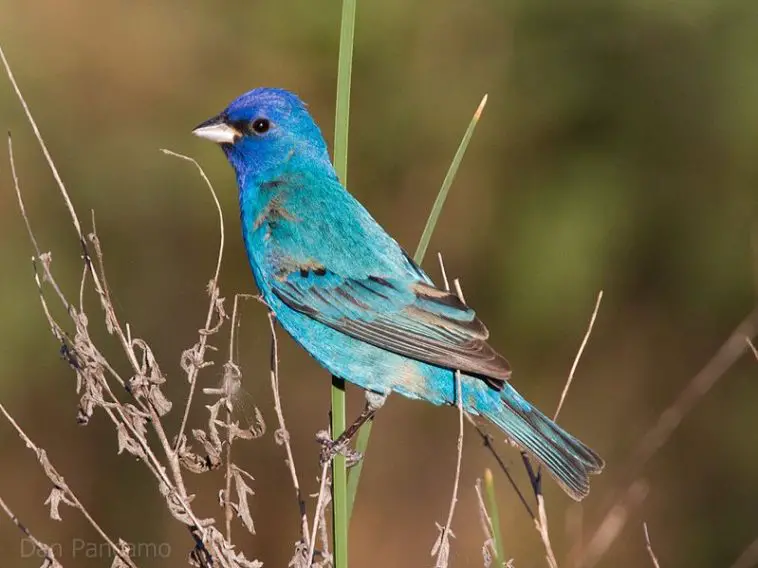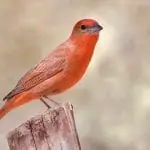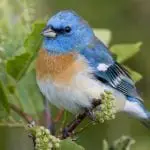Scientific Facts
| Common Name | Indigo Bunting |
| Scientific Name | Passerina cyanea |
| Life Span | Up to 10 years (in the wild) |
| Size | 4.5 to 5 inches |
| Habitat | Farms, woods, roads, power lines, Riparian habitats, railways, etc. |
| Country of Origin | United States |
Overview
Once you spot a pure blue-colored bird on the roadsides in Tennessee on one hot summer day, then that could be an indigo bunting. Compared to the eastern bluebird that has a white and rusty belly, a male indigo bunting is purely blue that shines through when the sunlight touches its feathers.
It is among the most widely distributed and most abundant bird that lives in most parts of the United States. You may find it in the shrubby areas or weedy fields in the country. The indigo bunting has been known as a songbird, which is true for the male. It sings constantly in summer. Its song is double-phrased and quite distinctive.
The indigo bunting is a great migratory bird that can travel long distances. What’s surprising is that it’s capable of flying to up to more than a thousand miles between its summer range in the east of North America and its winter range in the south of Florida, Central America, Mexico, and the Caribbean. The indigo bunting arrives in Tennessee by mid-April and leaves by mid-October.
Like other small songbirds, the indigo bunting is also a seed-eater. It migrates not only when the season changes but even it’s ready to mate and reproduce. The bird flies from the south of Canada, going to the north of Florida to breed and from the south of Florida to the north of South America in winter.
Since it travels in long distances, the indigo bunting prefers to migrate in the evening and depends on the stars for navigation. The Lazuli Bunting is closely related to this bird.
Physical Description
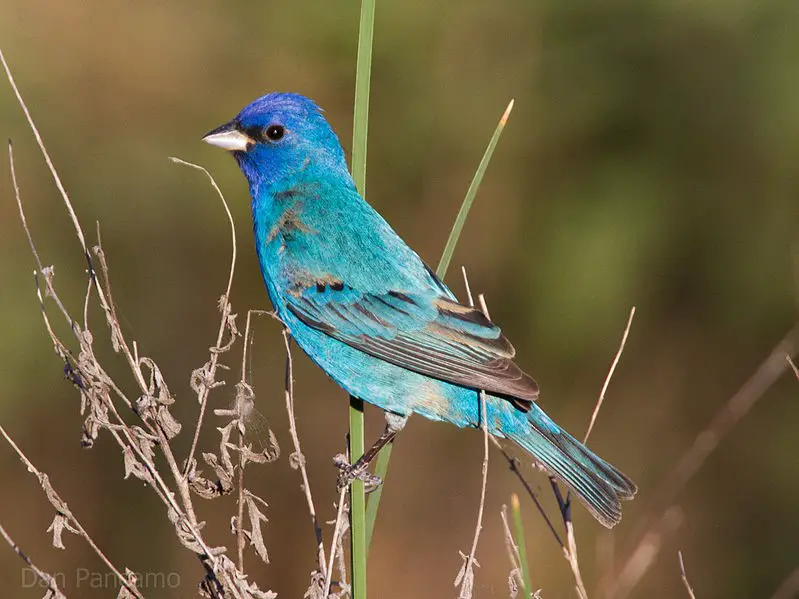

The indigo bunting is a tiny bird that measures 4.5 to 5 inches long. The colors of the feathers differ between a male and a female. An adult male comes in the bright blue shade in summer, but its color changes to brown in winter. The female and immature male, however, stays brown throughout the year.
The plumage of a male indigo bunting is brightly colored during the mating season so that it can easily entice a female. The construction of the nest and incubation are both responsibilities of the female that it needs to do on its own.
While it is a seed-eater, the indigo bunting tends to eat insects for some time. Search for the indigo bunting in mid-summer along the rural streets where it often sings while perching on the telephone lines and wooded edges for several hours.
You can distinguish the indigo bunting from other blue-colored birds in many ways. One of these is recognizing the bouncy quality of those paired notes in its song. When migrating, big flocks of the indigo buntings feed in agricultural areas and lawns.
When its blue color changes to brown in fall, the bird becomes difficult to spot. However, the bluish streaks in a bird’s wings and tail will tell you it is an indigo bunting.
Color Pattern
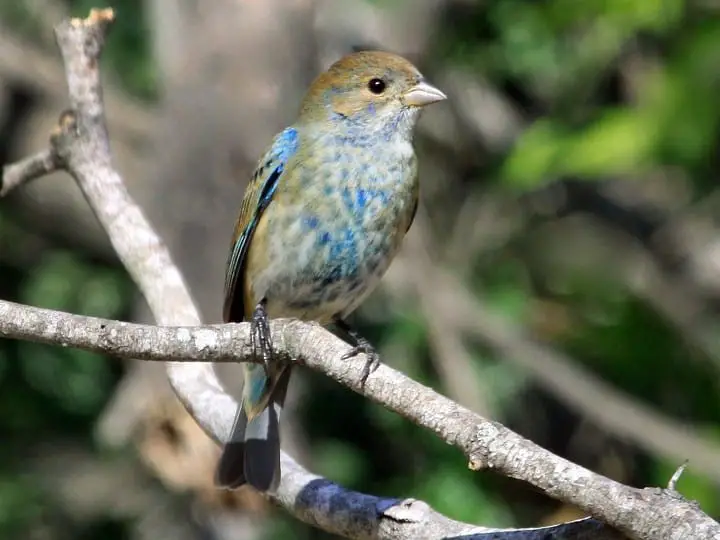
In summer, the feathers of a mature male indigo bunting are dark blue that may look black in low light conditions. The bird has a black tail and wings with blue streaks on the edges.
As said before, the male indigo bunting changes the color of its feathers in fall and winter. It is a normal process that happens every year. When it happens, both male and female indigo buntings will look the same that makes it hard to identify their genders.
Also, it’s so easy to wrongfully identify a male indigo bunting for another brown-colored bird. Good thing, it somehow retains some blue feathers on its tail and wings that help a lot in distinguishing the bird itself.
A mature female indigo bunting has brown feathers and pale dark markings on its underside, particularly on its breast area. Its throat is white. In rare cases, it even has bluish markings on its tail, wings, and rump.
This coloration for the female does not change regardless of the season. The same is the case for a young or immature male indigo bunting. It may have blue patches on some body parts. At the end, when a young male becomes sexually mature, its feathers will turn to blue with a darker shade of blue on its head and a glossy silver-gray beak.
Geographic Range
The indigo bunting breeds across the east of North America from eastward Great Plains, the south portion of the coniferous forest area. Some breeding birds can also be found in the west of the United States, specifically in Arizona, California, and Utah. In winter, this bird will be in the coastal areas of Central America, Mexico, the Caribbean, and northern South America.
Habitat
The indigo bunting breeds in the weedy and brushy areas along the boundaries of farmlands, woods, power lines, roads, railways, or riparian habitats. The bird may also breed in the cleared open deciduous forests, abandoned or weedy agricultural fields, or swamps.
While migrating, it searches for open grasslands or leafy trees that resemble its preferred habitat for winter months. In this season, the indigo bunting chooses open habitats like weedy fields, savannas, citrus orchards, weedy croplands, or low-second growth.
You may likely find the indigo bunting hopping and eating in the brushy and weedy areas, particularly in the fields next to forests. This bird likes hedgerows, edges, overgrown patches, and even the brushy roadsides. Often, the bird perches on the peak of the tree and sings. If not, you may see it foraging on the seed-laden grasses and shrubs.
Also, the indigo bunting may prefer spending the winter months in backyards with birdhouses and feeders. The bird will settle for a perfect spot where it can keep itself safe and find a stable supply of food and water.
Distribution and Status
This bird is more common in the deciduous forests across the east of the United States. In the southwest of the country, this bird is easier to find in its riparian habitats. In winter, the bird has been spotted in Mexico up to Central America while rarely in the north of South America. Some populations stay in the Caribbean islands.
The indigo bunting is rare in the Gulf Coast and South Florida. The bird is expected to be at the breeding ground in mid-April to early-June. In autumn, the bird arrives at its preferred breeding grounds in mid-September to mid-October. However, it is rare to Atlantic provinces and Pacific states.
Similar Species
The closely associated blue grosbeak resembles the indigo bunting. It may also look black in low-light conditions, but the blue grosbeak is bigger than the indigo bunting. Besides, it has a much bigger bill. When exposed to good lighting, the blue grosbeak also comes with 2 brownish wing bars.
Moreover, the blue grosbeak is uncommon in most portions of Missouri, but the indigo bunting seems widely available all over the state. The eastern bluebird is a kind of thrush. It is bigger and with a slimmer beak compared to blue grosbeak. Every eastern bluebird has orange-colored feathers on its breast and white ones on the belly.
The lazuli bunting is not common in the west of Missouri, especially in spring. A male lazuli bunting also has orange-colored feathers on its breast and white feathers on the belly just like the eastern bluebird.
Indigo Bunting vs. Painting Bunting
Buntings eat seeds and even insects. They also have conical and stubby beaks. They are somewhat equivalent to the sparrow though they are not exactly related to one another. In terms of the habitat, buntings have the same preferences as the finches.
Buntings are available in two different species: the indigo and painted buntings. They are all members of the Cardinal family. The painted bunting is bright red, blue, and green and also classified as a songbird. This bird is from North America.
The male painted bunting transforms itself to become more enticing for females. The color of a painted bunting becomes brighter during the mating season. However, its shyness and favored habitats, such as the woodlands and thickets, make them hard to spot.
The species have 2 breeding populations: one is in the south-central US. The other is on the seaboard of the Southeastern US.
A painted bunting was previously known as a caged bird. However, its population is decreasing because of habitat destruction. Therefore, this bird has been enlisted as an endangered species in the US. Despite that, it remains as a target of the trappers due to its bright plumage. It’s a common pet bird in Mexico.
The male indigo bunting, as the name suggests, looks like a bright bluebird throughout the breeding period. It is usually seen along the roadsides and in the old fields.
It migrates from Canada to northern Florida to breed up to the south of northern South America. It prefers to stay in abandoned land instead of the urban region, intensely farmed regions, and deep forests. The young and female indigo buntings are brown.
Life Span and Longevity
The indigo bunting can live for up to 10 years in the forests. In captivity, the bird is more likely to live longer with proper care.
During the mating season, the male indigo bunting will choose a breeding territory and defend it. A female, however, chooses the best nesting site and makes a nest made of grass, leaves, and barks in the shrubs. The bird will lay 1 to 5 eggs and incubate them for 12 to 14 days.
Likewise, the female will feed and care for the hatchlings. The babies will fledge by the age of 8 to 14 days old. However, they will stay with the mother for another couple of weeks. A female indigo bunting might have up to 2 broods in a year.
A Nonstop Singer
A male indigo bunting is a persistent singer. You will see it warbling its sweet double-phrased song while perching on telephone wires, treetops, or any other elevated areas where the bird can perch. Its sharp “spik” call sound is more common and easier to recognize.
The same with the song sparrows, the young indigo bunting, observes and mimics the mature males to learn how to sing. They develop their unique phrasings in the long run.
Seasonal Changes
Like the scarlet tanager and black-throated blue warbler, this species is sexually dimorphic. Only the male has blue feathers that appear only during the breeding season. Then, all indigo buntings, whether male or female and young or old, will be brown from head to tail.
The indigo bunting, just like the painted buntings, undergoes diet changes based on the season. It eats spiders and other small insects in summer, which gives them extra protein that is necessary for the nesting period. Also, this bird eats buds, seeds, and berries when migrating and during winter. The bunting can be advantageous to farmers, as it eats a lot of weed seeds and insect pests.
Migration
Since the indigo bunting is a migratory species. It moves to other parts of the United States during the breeding season and when the winter months come in. This bird succeeds in migrating as it uses the stars that guide them to the right spots. Migration happens in April to May and September and October. If kept in captivity and not allowed to migrate, this bird is more likely to become confused if it can’t see the stars.
Furthermore, the indigo bunting has been found as a vagrant in other distant countries like the UK, Denmark, Ireland, Iceland, Germany, Antigua, Ecuador, Barbados, the Netherlands, Antilles, and even Serbia.
In winter, the indigo bunting is more common in Central Mexico and northern South America. However, it’s more common from the east coast of Mexico up to Costa Rica. Spring migration takes place along the wide front, involving the Gulf of Mexico. The population which breeds in New Mexico and Arizona doesn’t take the shortest and fastest direction from Mexico. This bird flies in entire Texas before it turns to the southwest.
The discoveries regarding the mechanisms of navigation and orientation in the migratory species came from the experiments conducted together with the indigo buntings. By using the captive-raised birds in the planetarium, Steven and John Emeling manipulated the look of the stars and confirmed that the indigo buntings depend on the movement of the stars that surround the North Star instead of tracking only the North Star.
Communication and Perception
This bird is using vocalizations and visual cues to communicate. It can create different sounds that serve as alarms or threats. Likewise, this bird creates sound to communicate with other birds during flight.
In courtship, the male indigo bird sings to entice a female and inform other males that it owns the territory. The bird usually sits on higher perches like posts and trees.
Voice
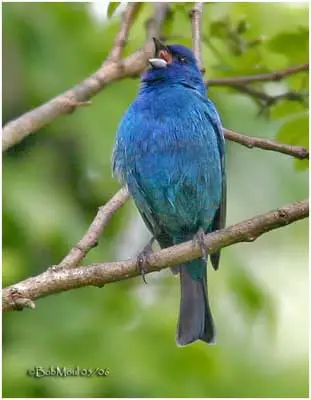
The calls of an indigo bunting involve the short buzzed “bzeet” and the sharp “tzik” sounds. The song of this bird is a variety of clear and quick high-pitched notes that descend in pitch and fade to the end.
Reproduction
The indigo bunting is socially monogamous. On the other hand, pairs just associate themselves until the incubation period starts. Also, these buntings may change partners in just one breeding period. Fertilizations occurring out of the breeding pair are not common, and around 15% of the male indigo buntings have two or more mating partners.
The male bird does courtship displays, which include swaggering in circles while facing the female while spreading its wings and crouching its head. The indigo bunting chooses only one mating partner in most cases, but it is not unusual to see it mating with 2 or more females.
A female indigo bunting raises up to 2 broods per breeding season. Aside from that, it may switch mates or nests between broods.
The male indigo bunting does not sing when courting a female, but it follows its mating partner during nest construction and egg-laying periods.
Mating System
The indigo bunting breeds between May and September. It tends to be more active occurring in June until August. In some cases, the female bird raises more than 1 brood in every mating season. Also, it may look for another rest or mating partner between broods.
The female will also choose a nest site and construct a nest that might take as much as 8 days. The nest is made of the plants in the fields or wood edges, railways, and roadsides. Also, the female builds it by using grasses, leaves, bark strips, and stems.
When the nest is ready, the bird will lay 1-4 white eggs. On average, a female indigo bunting lays 3-4 eggs. The bird will lay one egg in a day, which happens right after the sunrise. Then, it begins incubating the eggs after laying the last egg. The incubation period will take 11-14 days. In most cases, this period lasts 12-13 days.
The female indigo bunting broods the altricial hatchlings in the first few days of their lives. Likewise, the bird will feed them with insects and eliminate the fecal sacs of the babies from the nest. The hatchlings will leave the nest in 8-14 days after the eggs hatched. Then, they will become independent at around 3 weeks after they fledged. Besides, the young indigo bunting will become sexually mature at the age of 1.
The male doesn’t help the female in incubating and raising the hatchlings. The female will choose a nest site and construct the nest. Also, it will brood the hatchlings in the first few days of their lives, feeds them with insects, eliminate the feces from the nesting spot. Sooner, the young indigo buntings will learn how to take care of themselves.
Nesting
A male indigo bunting establishes its territory during spring and tries to protect it from other birds and predators by singing. It might have two or more mating partners that will live altogether with him in his territory.
The nesting spot is normally 1 to 3 feet away from the ground, but it can also be as much as 30 feet high. The nest of an indigo bunting often sits in dense shrubs or low trees. Later on, these birds may nest in big weeds like the goldenrod. This nesting site is a cup-shaped structure made of natural materials found within the male’s territory.
Eggs
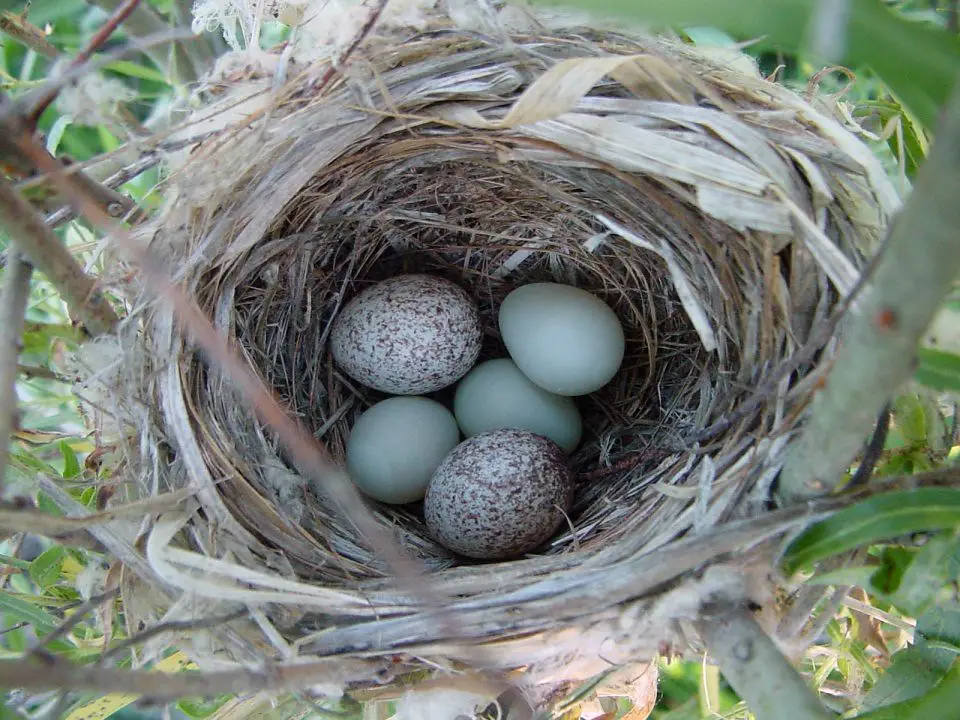
In most cases, a female indigo bunting lays 3 to 4 eggs. It lays 1 to 2 eggs only in fewer cases. The eggs are white with either brownish or purplish spots. Once laid, the mother will incubate the eggs for up to 2 weeks.
Only the female will take care of the hatchlings and feed them. The male will likely help her in feeding the hatchlings when they are almost enough and ready to fledge. Fledging occurs in the next 9 to 12 days. At times, the male will take charge and feed them the hatchlings after they fledged. In this period, the female will work on the 2nd nesting attempt, which will be the last for the current year.
Hatchlings

The hatchlings are born naked with their eyes still closed. They are still weak, so they depend a lot on their mother in the meantime. At first, only the female indigo bunting will focus on feeding the hatchlings. The male will help only when the hatchlings are almost ready to fly. Once it happens, the male will be the main food provider for the hatchlings. It will allow the female to build another nest and breed for the second time.
Behavior
The indigo bunting is solitary in general. It wanders and feeds on its own, but will look for a companion only when the breeding season arrives. At this period, the male becomes aggressive and too defensive after claiming a territory where it will live with its preferred mating partner. This territory is usually 0.4-8 ha.
Every territory might hold 1 or more females. During winter, this bird roosts in a flock in the evening, but it will spend days in forage alone or with other birds. It seems no domination hierarchy in these groups.
Aside from being solitary, the indigo bunting is good at traveling at longer distances. It can fly for up to 2,000 miles between its breeding and wintering grounds. It leaves the breeding site in September or October and flies from its wintering grounds going to the breeding site in late April or May. The flight always happens at night.
While the male bird sings, it perches and swishes its tail from left to right. During the breeding period, this species prefers to be on its own and will look for others only during migration and winter months.
When it comes to threats, the indigo bunting uses a special trick to fool other animals. If a predator is approaching the nest, the adults will pretend to be injured and sing the “chip-chip-chip” phrase to distract the animal and encourage it to leave. Likewise, this bird doesn’t mob predators.
Flight
The indigo bunting will gather with other birds and fly in groups at night. Their wings are strong enough to travel thousands of miles during a flight.
Diet and Nutrition

During the mating season, this species eats tiny insects and spiders, seeds, and berries. For insects, its best options are grasshoppers, caterpillars, bugs, and beetles. Insects are good sources of protein which the indigo bunting needs for successful nesting.
During winter, the bird will settle for buds, smaller seeds, and a few insects. Its main food for this season will be the tiny seeds of weed. The indigo bunting is quite voracious and will eat as often as it can. When it’s in the rice fields, it picks and consumes the rice seeds.
Water is also essential, but the indigo bunting does not drink frequently. That’s because it may get enough water from food.
Moreover, the indigo bunting may eat alone or in groups depending on the season. It does not store foods for future consumption.
Predation
Though the predation for an adult indigo bunting happens for some time, specific predators were not identified. However, the brooding females, juveniles, and eggs are prone to predation involving climbing predators. These include raccoons, red foxes, opossums, feral cats, blue racers, and blue jays.
It does not attack the predators. Instead, it pretends to be injured and tries to discourage predators.
The Indigo Bunting and Its Role in the Ecosystem
Perching birds play a big role in the ecosystems of the planet. These species consume a wide variety of food and usually in large quantities. Likewise, these animals serve as foods to other animals.
The indigo buntings significantly affect the populations of those insects they consume. At the same time, when they eat berries, they help in the distribution of their seeds that lead to the growth of new plants. Also, these birds serve as a host for just one parasite: hippoboscid flies.
The Indigo Bunting and Its Positive and Negative Economic Significance for Humans
There’s the apparent significance of the songbirds such as the indigo buntings to bird watchers. These bright-colored birds are commonly kept and raised in captivity. Indigo buntings don’t cause harm to people.
Conservation Status
The populations of indigo buntings stay stable and abundant. Thus, this species is currently not listed as endangered.
Availability – Where to Get One?
Since the indigo bunting is kept as a pet nowadays, this bird is more likely available in the pet stores on the web and locally. Also, you may try finding a good pair of indigo buntings from the breeders.
How to Care for an Indigo Bunting?
An indigo bunting is a nice songbird to keep in captivity. Everyone will be entertained once this bird sings. Proper care, feeding, and caging are necessary to keep it active, healthy, and happy. This bird likes perching, so a bigger and taller caging will be a perfect choice in keeping this animal.
Attracting an Indigo Bunting
To sing on the roadside seems to be a pastime for an indigo bunting. If your car is passing through rural roads, open the window, and wait until you hear a song. Singing is a passion for an indigo bunting. It can spend hours in singing a song.
Also, this bird seems active at dawn, wherein it can sing as much as 200 songs per hour and spend the rest of the day singing a song per minute. Each of the songs that the indigo bunting sings is a bit different from the rest because juveniles learn the songs from the male bird where they grew. It leads to the so-called “song neighborhoods.” Here, the nearby males sing those songs which are comparable to one another and different from those songs sung from birds that are a few hundred meters away from them.
Since the indigo bunting tends to be timid at feeders, opt to caged tube feeders that will protect the bird from bigger birds. Fill the feeders with Nyjer seeds or sunflower seeds. You may also add some mealworms placed in the hanging hoppers or platform feeders. These will help you entice the indigo bunting to visit and stay in your backyard.
How to Build a Birdhouse for an Indigo Bunting?
The best birdhouse for this species is the one with a wide floor measuring 5 by 5 inches and an interior ceiling measuring 8 inches. Aside from that, the birdhouse must have an entrance hole that measures 1 ¾ to 2 ¾ inches in diameter. The birdhouse itself should sit 2-10 feet away from the ground. Once the birdhouse is ready, put it in herbaceous plants or shrubs near the ground.
Fun Facts about the Indigo Bunting
The indigo bunting migrates at night and uses the stars as a guide. Researchers assessed this process in the late 1960s. They conducted an experiment involving captive birds in the planetarium and put them underneath the night sky. These birds have an “internal clock,” which allows them to continuously adapt their orientation angle to a star even if that star is moving through the sky.
The indigo bunting learns its songs at an early age. It listens to the other males perching near them and learn the songs from them, instead of their fathers. Those birds that are a hundred yards from the juveniles often sing various songs while the birds in the neighborhood share almost the same songs. For a local song, it may last for 20 years and will slowly change as the young singers add note variations.
Like other blue-colored birds, the indigo bunting lacks the blue pigment. Its jewel-like color is the result of the microscopic structures on its feathers which alter and replicate the blue light, just like the aerial particles that make the sky appear blue.
The plumage of an indigo bunting contains melanin that gives a pale brown-black coloration.
Both lazuli and indigo buntings protect their territories against one another within the western Great Plains wherein these birds live together, share different songs, and interbreed for some time.
The oldest indigo bunting that lived in the wild was a male. It was 13 years and 3 months when the researchers recollected and rereleased it during the banding activity held in Ohio.
FAQs
Can I keep an indigo bunting as a pet?
The indigo bunting is a migratory bird which can also be kept as a pet. Take note of its feeding and caging requirements.
How long does the indigo bunting grow?
The indigo bunting is a small songbird. On average, it measures 4.5 to 5 inches long.
What is the normal life span of an indigo bunting?
The indigo bunting tends to have a shorter life span when living in the wild. On average, this bird lives for up to 10 years.
Is an indigo bunting a great songbird?
The indigo bunting seems to be one of the best of all, songbirds on earth. This species can sing for as many as 200 beautiful songs.
Does the indigo bunting sing during courtship?
This songbird stays quiet during courtship. Instead, the male tries to impress its prospect by doing its popular courtship display in front of the female.
What does the indigo bunting eat?
Like other songbirds, the indigo bunting is a seed-eater. It eats mainly seeds and some insects for protein.
Is the indigo bunting aggressive?
The male indigo bunting is more prone to aggression compared to a female. It becomes aggressive during the breeding season, especially when it searches for territory and in protecting it.
How can I tame an indigo bunting?
An indigo bunting might be shy, but providing it with food and a nice birdhouse will help you get its trust. Taming an indigo bunting takes time, so you need to be patient when doing so.
Is the indigo bunting a migratory species?
The indigo bunting is a migratory bird that can endure long-distance flights. It can even go outside of the United States as it was spotted foraging in the UK, the Netherlands, Serbia, etc.

